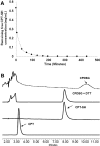Redox potential ultrasensitive nanoparticle for the targeted delivery of camptothecin to HER2-positive cancer cells
- PMID: 24779647
- PMCID: PMC4334268
- DOI: 10.1021/mp5000482
Redox potential ultrasensitive nanoparticle for the targeted delivery of camptothecin to HER2-positive cancer cells
Abstract
Ideal "smart" nanoparticles for drug delivery should enhance therapeutic efficacy without introducing side effects. To achieve that, we developed a drug delivery system (HCN) based on a polymer-drug conjugate of poly[2-(pyridin-2-yldisulfanyl)]-graft-poly(ethylene glycol) and camptothecin with an intracellularly cleavable linker and human epidermal growth factor receptor 2 (HER2) targeting ligands. An in vitro drug release study found that HCN was stable in the physiological environment and supersensitive to the stimulus of elevated intracellular redox potential, releasing all payloads in less than 30 min. Furthermore, confocal microscopy revealed that HCN could specifically enter HER2-positive cancer cells. As a consequence, HCN could effectively kill HER2-positive cancer cells while not affecting HER2-negative cells.
Figures






Similar articles
-
pH and redox dual responsive nanoparticle for nuclear targeted drug delivery.Mol Pharm. 2012 Sep 4;9(9):2719-29. doi: 10.1021/mp300274g. Epub 2012 Aug 22. Mol Pharm. 2012. PMID: 22876763
-
Targeted nanoparticles assembled via complexation of boronic-acid-containing targeting moieties to diol-containing polymers.Bioconjug Chem. 2013 Apr 17;24(4):669-77. doi: 10.1021/bc300640j. Epub 2013 Mar 18. Bioconjug Chem. 2013. PMID: 23461746 Free PMC article.
-
Using doxorubicin and siRNA-loaded heptapeptide-conjugated nanoparticles to enhance chemosensitization in epidermal growth factor receptor high-expressed breast cancer cells.J Drug Target. 2013 Sep;21(8):776-86. doi: 10.3109/1061186X.2013.811511. Epub 2013 Jul 5. J Drug Target. 2013. PMID: 23829387
-
Lipid-polymer hybrid nanoparticles as a new generation therapeutic delivery platform: a review.Eur J Pharm Biopharm. 2013 Nov;85(3 Pt A):427-43. doi: 10.1016/j.ejpb.2013.07.002. Epub 2013 Jul 17. Eur J Pharm Biopharm. 2013. PMID: 23872180 Review.
-
Novel HER2-Targeting Antibody-Drug Conjugates of Trastuzumab Beyond T-DM1 in Breast Cancer: Trastuzumab Deruxtecan(DS-8201a) and (Vic-)Trastuzumab Duocarmazine (SYD985).Eur J Med Chem. 2019 Dec 1;183:111682. doi: 10.1016/j.ejmech.2019.111682. Epub 2019 Sep 6. Eur J Med Chem. 2019. PMID: 31563805 Review.
Cited by
-
Photosensitizer and peptide-conjugated PAMAM dendrimer for targeted in vivo photodynamic therapy.Int J Nanomedicine. 2015 Nov 3;10:6865-78. doi: 10.2147/IJN.S89474. eCollection 2015. Int J Nanomedicine. 2015. PMID: 26604753 Free PMC article.
-
A Unique Core-Shell Structured, Glycol Chitosan-Based Nanoparticle Achieves Cancer-Selective Gene Delivery with Reduced Off-Target Effects.Pharmaceutics. 2022 Feb 7;14(2):373. doi: 10.3390/pharmaceutics14020373. Pharmaceutics. 2022. PMID: 35214105 Free PMC article.
-
Glutathione-Sensitive Mesoporous Organosilica-Coated Gold Nanorods as Drug Delivery System for Photothermal Therapy-Enhanced Precise Chemotherapy.Front Chem. 2022 Feb 25;10:842682. doi: 10.3389/fchem.2022.842682. eCollection 2022. Front Chem. 2022. PMID: 35281558 Free PMC article.
-
Cancer cell-selective killing polymer/copper combination.Biomater Sci. 2016 Jan;4(1):115-20. doi: 10.1039/c5bm00325c. Biomater Sci. 2016. PMID: 26568413 Free PMC article.
-
Redox-Sensitive Nanocomplex for Targeted Delivery of Melittin.Toxins (Basel). 2020 Sep 10;12(9):582. doi: 10.3390/toxins12090582. Toxins (Basel). 2020. PMID: 32927695 Free PMC article.
References
-
- Master A. M.; Rodriguez M. E.; Kenney M. E.; Oleinick N. L.; Gupta A. S. Delivery of the photosensitizer Pc 4 in PEG-PCL micelles for in vitro PDT studies. J. Pharm. Sci. 2010, 9952386–2398. - PubMed
-
- Moreira J. N.; Gaspar R.; Allen T. M. Targeting stealth liposomes in a murine model of human small cell lung cancer. Biochim. Biophys. Acta 2001, 15152167–176. - PubMed
-
- Shi M.; Ho K.; Keating A.; Shoichet M. S. Doxorubicin-Conjugated Immuno-Nanoparticles for Intracellular Anticancer Drug Delivery. Adv. Funct. Mater. 2009, 19111689–1696.
Publication types
MeSH terms
Substances
Grants and funding
LinkOut - more resources
Full Text Sources
Other Literature Sources
Medical
Research Materials
Miscellaneous

